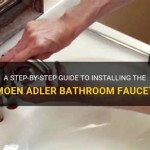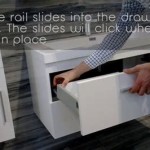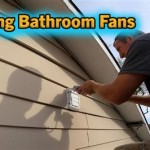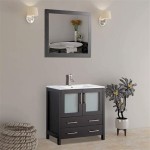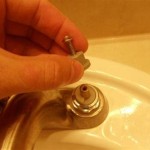How To Prevent Bathroom Mirror Fogging
Bathroom mirror fogging is a common inconvenience stemming from the condensation of water vapor onto the cool surface of the mirror after a hot shower or bath. The warm, moisture-laden air comes into contact with the relatively colder mirror, causing the water vapor to transition from a gaseous state to a liquid state on the mirror’s surface. This process results in the formation of a thin layer of water droplets, scattering light and obscuring the reflected image. Addressing this issue involves managing the temperature differential between the air and the mirror or reducing the overall humidity within the bathroom.
Applying Anti-Fog Sprays
Anti-fog sprays provide a temporary solution to bathroom mirror fogging. These sprays typically contain surfactants, which are substances that lower the surface tension of water. When applied to the mirror's surface, the surfactants cause the water to spread out into a thin, transparent film instead of forming individual droplets. This film allows light to pass through without scattering, maintaining a clear reflection. The effectiveness of these sprays varies depending on the specific product and the environmental conditions within the bathroom. Regular reapplication is necessary, as the coating degrades over time due to repeated exposure to water and cleaning.
The application process for anti-fog sprays generally involves cleaning the mirror thoroughly to remove any existing dirt, grime, or residue. The spray is then applied evenly across the surface of the mirror and allowed to dry according to the manufacturer's instructions. Some sprays require buffing with a clean cloth to achieve optimal clarity. It is crucial to follow the specific instructions provided with the product to ensure proper application and prevent streaking or residue buildup. Furthermore, it's important to choose anti-fog sprays that are specifically designed for bathroom mirrors, as some products may contain harsh chemicals that could damage the mirror's reflective coating.
While anti-fog sprays offer a relatively quick and easy solution, they are not a permanent fix. The duration of their effectiveness can range from a few days to a couple of weeks, depending on factors such as the humidity levels in the bathroom, the frequency of showers or baths, and the quality of the spray. Therefore, users should be prepared to reapply the spray regularly to maintain a fog-free mirror. In addition to commercially available sprays, some individuals have reported success using homemade solutions containing ingredients like vinegar or dish soap. However, caution should be exercised when using homemade remedies, as some ingredients may be abrasive or corrosive and could potentially damage the mirror's surface.
Using a Hair Dryer
Employing a hair dryer represents a simple and readily available method for clearing a fogged bathroom mirror. The hair dryer works by directing warm air onto the surface of the mirror, raising its temperature and reducing the temperature difference between the mirror and the surrounding air. This reduction in temperature differential minimizes the condensation of water vapor, effectively clearing the fog. The process is relatively quick and requires no specialized equipment or chemicals.
To utilize a hair dryer effectively, it is recommended to hold it at a safe distance from the mirror, typically around 6-12 inches, to prevent overheating or potential damage to the mirror's surface. Direct the warm air evenly across the entire surface of the mirror, moving the hair dryer in a sweeping motion to ensure uniform heating. Avoid concentrating the heat in one area for an extended period, as this could potentially cause thermal stress or cracking. The time required to clear the fog will vary depending on the severity of the fogging and the power of the hair dryer.
While using a hair dryer is a convenient short-term solution, it is not a sustainable or energy-efficient method for preventing fogging. It requires continuous use during and after a shower or bath to maintain a clear mirror, consuming electricity and potentially contributing to increased energy bills. Furthermore, the constant exposure to warm air may gradually dry out the mirror's backing, potentially leading to deterioration over time. Therefore, while effective for immediate fog removal, using a hair dryer should be considered a temporary measure rather than a long-term solution.
Improving Bathroom Ventilation
Enhancing bathroom ventilation is a proactive approach to mitigating mirror fogging by reducing the overall humidity within the bathroom. Excess humidity is the primary cause of condensation on the mirror's surface, so effectively removing moist air can significantly minimize fogging. Improved ventilation can be achieved through various methods, including the installation or upgrade of exhaust fans, opening windows, or using dehumidifiers.
Exhaust fans are specifically designed to remove moist air from the bathroom and vent it to the outside. They are typically installed in the ceiling or wall and activated during showers or baths. When selecting an exhaust fan, it is crucial to consider the size of the bathroom and choose a fan with an appropriate airflow capacity, measured in cubic feet per minute (CFM). A general guideline is to have at least 1 CFM per square foot of bathroom space. It is also important to ensure that the exhaust fan is properly vented to the outside, preventing the moist air from recirculating within the building. Regular maintenance, such as cleaning the fan blades and ensuring proper airflow, is necessary to maintain the fan's optimal performance.
Opening windows during and after showers or baths can also help to improve ventilation and reduce humidity levels. The natural airflow can carry away moist air and replace it with drier air from outside. However, this method is only effective when the outdoor humidity is lower than the indoor humidity. In humid climates, opening windows may actually exacerbate the problem. The effectiveness of this method also depends on the size and location of the windows and the overall airflow within the bathroom.
Dehumidifiers are another option for reducing humidity levels in the bathroom. These devices work by removing moisture from the air and collecting it in a reservoir. Portable dehumidifiers can be placed in the bathroom during and after showers or baths to help absorb excess moisture. The size and capacity of the dehumidifier will depend on the size of the bathroom and the severity of the humidity problem. Regular maintenance, such as emptying the water reservoir and cleaning the filters, is necessary to maintain the dehumidifier's efficiency. While dehumidifiers can be effective at reducing humidity, they can also be relatively noisy and may require frequent emptying of the water reservoir.
Applying Shaving Cream
Applying a thin layer of shaving cream to the mirror surface and then wiping it off provides another DIY method for preventing fogging. This technique leverages the surfactants present in shaving cream, similar to the mechanism of commercially available anti-fog sprays. The surfactants create a thin film on the mirror, preventing water droplets from forming and thus maintaining a clear reflection. The effectiveness of this method may vary based on the type of shaving cream used and the environmental conditions within the bathroom.
The application process involves first applying a thin layer of shaving cream to the entire surface of the mirror. It is crucial to use a non-gel shaving cream for optimal results. Allow the shaving cream to sit on the mirror for a minute or two to allow the surfactants to bind to the surface. Next, using a clean, dry cloth, thoroughly wipe off the shaving cream. The goal is to remove the bulk of the cream while leaving behind a very thin, almost imperceptible film. Buffing the mirror with a clean, dry cloth after wiping can further enhance clarity and remove any remaining residue.
While this method is often cited as a cost-effective and readily available solution, its effectiveness can be inconsistent. The longevity of the anti-fog effect is typically shorter compared to commercial anti-fog sprays, often lasting for just a single shower or bath. The type of shaving cream used can also impact the results; creams with higher surfactant concentrations may provide better and longer-lasting protection. Furthermore, improper application, such as applying too much shaving cream or not wiping it off thoroughly, can lead to streaking or a cloudy residue on the mirror. Therefore, while a convenient option, applying shaving cream requires careful application and may need to be repeated frequently.
Install a Mirror Demister Pad
A mirror demister pad presents a more permanent and technologically advanced solution to bathroom mirror fogging. These pads are essentially heating elements that are adhered to the back of the mirror, gently warming the glass and preventing condensation. By maintaining a slightly above-room-temperature surface, the mirror avoids the temperature differential that causes fogging. This approach offers a consistent and reliable method for keeping the mirror clear, requiring minimal maintenance once installed.
Installation typically involves adhering the demister pad to the back of the mirror using a self-adhesive backing. The pad is then wired into the bathroom's electrical system, often connected to the lighting circuit so that it activates whenever the lights are switched on. This ensures that the mirror is always preheated and ready to resist fogging. It is highly recommended that a qualified electrician perform the installation to ensure safe and compliant wiring. Improper installation can pose a risk of electrical shock or fire hazard.
While demister pads offer a highly effective solution, they require an initial investment for the pad itself and the installation costs. The energy consumption of the pad is relatively low, typically comparable to a low-wattage light bulb, but it does contribute to overall electricity usage. One key consideration is the size of the demister pad. Ideally, the pad should cover a significant portion of the mirror's surface to provide adequate heating. Smaller pads may only clear a limited area, leaving the edges of the mirror still prone to fogging. Overall, a mirror demister pad represents a practical and long-lasting solution for eliminating bathroom mirror fogging, offering convenience and consistent performance.

3 Ways To Keep Mirrors From Fogging Up With Steam

3 Ways To Keep Mirrors From Fogging Up With Steam

How To Keep Your Bathroom Mirror Fog Free The Creek Line House

7 Easy Ways To Stop A Bathroom Mirror From Steaming Up City

How To Keep Your Bathroom Mirror Fog Free The Creek Line House

How Not To Clear A Foggy Bathroom Mirror L Nofogg

Tips To Prevent Your Bathroom Mirror From Steaming Up

How To Stop The Bathroom Mirror Steaming Up

7 Easy Ways To Stop A Bathroom Mirror From Steaming Up City

How Not To Clear A Foggy Bathroom Mirror L Nofogg
Related Posts


